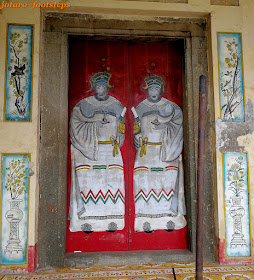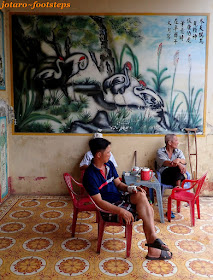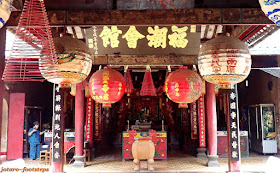You are at - Jotaro's Blog / Footsteps-Cycling Cambodia & Vietnam 2018 / Sites / Hokkien Clan Temple (Phước kien hội quán) @ My Tho
Footsteps - Jotaro's Travels
While visiting the My Tho Old Farmers' Market (Chợ Cũ) during a cycling tour in Vietnam, we found tucked behind the market, a nice old temple. It's actually a Chinese clan temple called the Hokkien-Teowchew Clan Temple. In Chinese the name indicated by Google Maps is 福潮會館(福建公所、潮州公所) which means "Fuzhou Association (Fujian Temple, Chaozhou Office)", meaning it's a clan temple for the Fujian (Hokkien) and Chaozhou (Teochew) people originating from Fuzhou (Foochow) area of China.
The main entrance door.
It's an old temple with fading paintwork and fading artwork, but it still captured our attention with its authenticity and old charm.
On each side of the main doors are two smaller doors, each with temple guards painted on each leaf. Above is the left door.
And this is the right side door. Both doors are closed and are probably only opened on festive occasions.
The temple guards looked friendly unlike those stern looking ones at other temples. A group of Vietnamese, including the caretaker, were chatting and sipping Chinese tea, peacefully below the eyes of the benign guards.
To each side of the main temple were annexes dedicated to the Hokkien and Teochew clans respectively. They may have separate door, but indoors they main temple and annexes are connected. A signboard above the entrance door stated "Phước kien hội quán" which means "Hokkien Assembly Hall".
On the other side is the Teochew Clan Annexe. The sign above the door states "Thiếu cháu hội quán" which means "Teochew Assembly Hall". No, those are not friendly temple guards but my cycling buddies, Fenn and Ying.
On both side walls of the main entrance were large mural paintings. This one on the right shows Red-crowned cranes in a lake scenery. That's the caretaker on the far right.
On the other wall was a mural of Spotted Deers in a mountain scenery.
On the high walls above the main doors were also wall panel painting, most of which depicted sceneries done in monotone Chinese brush style. At the centre is that of a Qilin. But what caught our attention were the two small panels besides the Qilin. These showed foreigners with their face and hands painted pinkish over the monochrome tones; were these French men who were somehow associated with the temple's past?
A close up look at the Qilin painting. It is done in Vietnamese style which like to emphasize on the detailing of the scales.
The roof joists and gable walls also had paintings of Chinese scenery, but these too were faded with age.
A close up of the painting on the left gable wall.
The right side roof joists and gable wall paintings.
Okay, let's go into the temple.
From the entrance door, a corridor with bright flowery tiles leads to the main prayer hall...
... er... but let's have a look at the paintings at the external wall next to the main door.
This one showed an old Chinese scene.
Another one showing an old Chinese scene.
This one showed loving birds...
... and the birds kissing lovingly.
Just above the main door is the temple's main sign board with two cute lions at its base.
A corridor with round Chinese lanterns hanging from above leads to the main prayer hall. On both sides of this corridor are open courtyards. On the other side of each courtyard are the clan annexes.
A view of two of the dragon lanterns, a blue one and a colourful one.
And a red one with a green dragon.
View of the main prayer hall, the main altar is at the centre while at the two sides are altars to secondary gods.
The main prayer altar. Like most Chinese temples, at the front-most is the incense burner, followed by the offering altar and at the far end the god's altar.
At one of the open air-well is a small pavilion for making offerings through the burning of hell notes.
I am not sure whether the lady in blue is the assistant caretaker, but her unique hat caught my attention.
On one side was a wall panel sculpture of a dragon flying in the blue sky. Below it seems to be a walled up pond. It's empty now, but most likely from the dragon's mouth water sprays into it.
On the other side was a wall panel sculpture of a tigress and her cub. This sculpture is done in a typical Vietnamese style of using porcelain shards to make ups the animals.
The tiger and dragons represents the yin and the yang; facing outwards the the tiger is always situated on the right.
Well, it's time to leave and continue our cycling. But it's raining, so it's time to say a prayer for the rain to stop.
_________________________________________________________________________________
Hokkien Clan Assembly Hall
(Phước kien hội quán)
ấp Mỹ An, Phường 8, Thành phố Mỹ Tho, Tiền Giang, Vietnam.
Entry fee: Free
GPS & Direction Map: 10.357699, 106.375960
The main entrance door.
It's an old temple with fading paintwork and fading artwork, but it still captured our attention with its authenticity and old charm.
On each side of the main doors are two smaller doors, each with temple guards painted on each leaf. Above is the left door.
And this is the right side door. Both doors are closed and are probably only opened on festive occasions.
The temple guards looked friendly unlike those stern looking ones at other temples. A group of Vietnamese, including the caretaker, were chatting and sipping Chinese tea, peacefully below the eyes of the benign guards.
To each side of the main temple were annexes dedicated to the Hokkien and Teochew clans respectively. They may have separate door, but indoors they main temple and annexes are connected. A signboard above the entrance door stated "Phước kien hội quán" which means "Hokkien Assembly Hall".
On the other side is the Teochew Clan Annexe. The sign above the door states "Thiếu cháu hội quán" which means "Teochew Assembly Hall". No, those are not friendly temple guards but my cycling buddies, Fenn and Ying.
On both side walls of the main entrance were large mural paintings. This one on the right shows Red-crowned cranes in a lake scenery. That's the caretaker on the far right.
On the other wall was a mural of Spotted Deers in a mountain scenery.
On the high walls above the main doors were also wall panel painting, most of which depicted sceneries done in monotone Chinese brush style. At the centre is that of a Qilin. But what caught our attention were the two small panels besides the Qilin. These showed foreigners with their face and hands painted pinkish over the monochrome tones; were these French men who were somehow associated with the temple's past?
A close up look at the Qilin painting. It is done in Vietnamese style which like to emphasize on the detailing of the scales.
The roof joists and gable walls also had paintings of Chinese scenery, but these too were faded with age.
A close up of the painting on the left gable wall.
The right side roof joists and gable wall paintings.
Okay, let's go into the temple.
From the entrance door, a corridor with bright flowery tiles leads to the main prayer hall...
... er... but let's have a look at the paintings at the external wall next to the main door.
This one showed an old Chinese scene.
Another one showing an old Chinese scene.
This one showed loving birds...
... and the birds kissing lovingly.
Just above the main door is the temple's main sign board with two cute lions at its base.
A corridor with round Chinese lanterns hanging from above leads to the main prayer hall. On both sides of this corridor are open courtyards. On the other side of each courtyard are the clan annexes.
A view of two of the dragon lanterns, a blue one and a colourful one.
And a red one with a green dragon.
View of the main prayer hall, the main altar is at the centre while at the two sides are altars to secondary gods.
The main prayer altar. Like most Chinese temples, at the front-most is the incense burner, followed by the offering altar and at the far end the god's altar.
At one of the open air-well is a small pavilion for making offerings through the burning of hell notes.
I am not sure whether the lady in blue is the assistant caretaker, but her unique hat caught my attention.
On one side was a wall panel sculpture of a dragon flying in the blue sky. Below it seems to be a walled up pond. It's empty now, but most likely from the dragon's mouth water sprays into it.
On the other side was a wall panel sculpture of a tigress and her cub. This sculpture is done in a typical Vietnamese style of using porcelain shards to make ups the animals.
The tiger and dragons represents the yin and the yang; facing outwards the the tiger is always situated on the right.
Well, it's time to leave and continue our cycling. But it's raining, so it's time to say a prayer for the rain to stop.
_________________________________________________________________________________
Hokkien Clan Assembly Hall
(Phước kien hội quán)
ấp Mỹ An, Phường 8, Thành phố Mỹ Tho, Tiền Giang, Vietnam.
Entry fee: Free
GPS & Direction Map: 10.357699, 106.375960
Related/Similar Blogs :
 |
 |
| Vietnam : Long Thieng Temple @ Vinh Long (Chùa Lòng Thiềng) |
 |
 |
| Vietnam : St. Joseph Cathedral, Hanoi |
 |
You May Also Like :
 |
 |
 |
 |
 |
 |
 |
 |
 |
| Malaysia - KevinTheBigCity Tattoos, Kuala Lumpur : July 2014 A look at a young man's simple but meaningful tattoos. |
 |
 |
 |
 |
You are at - Jotaro's Blog / Footsteps-Cycling Cambodia & Vietnam 2018 / Sites / Hokkien Clan Temple (Phước kien hội quán) @ My Tho
If you like this, view my other blogs at Jotaro's Blog
(comments most welcomed. if you like this pls share via facebook or twitter)
(comments most welcomed. if you like this pls share via facebook or twitter)














































































